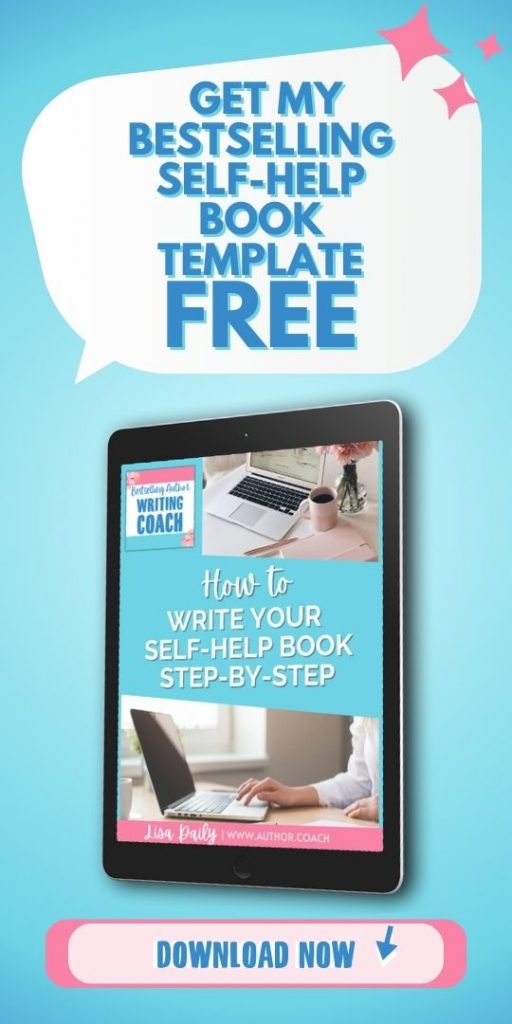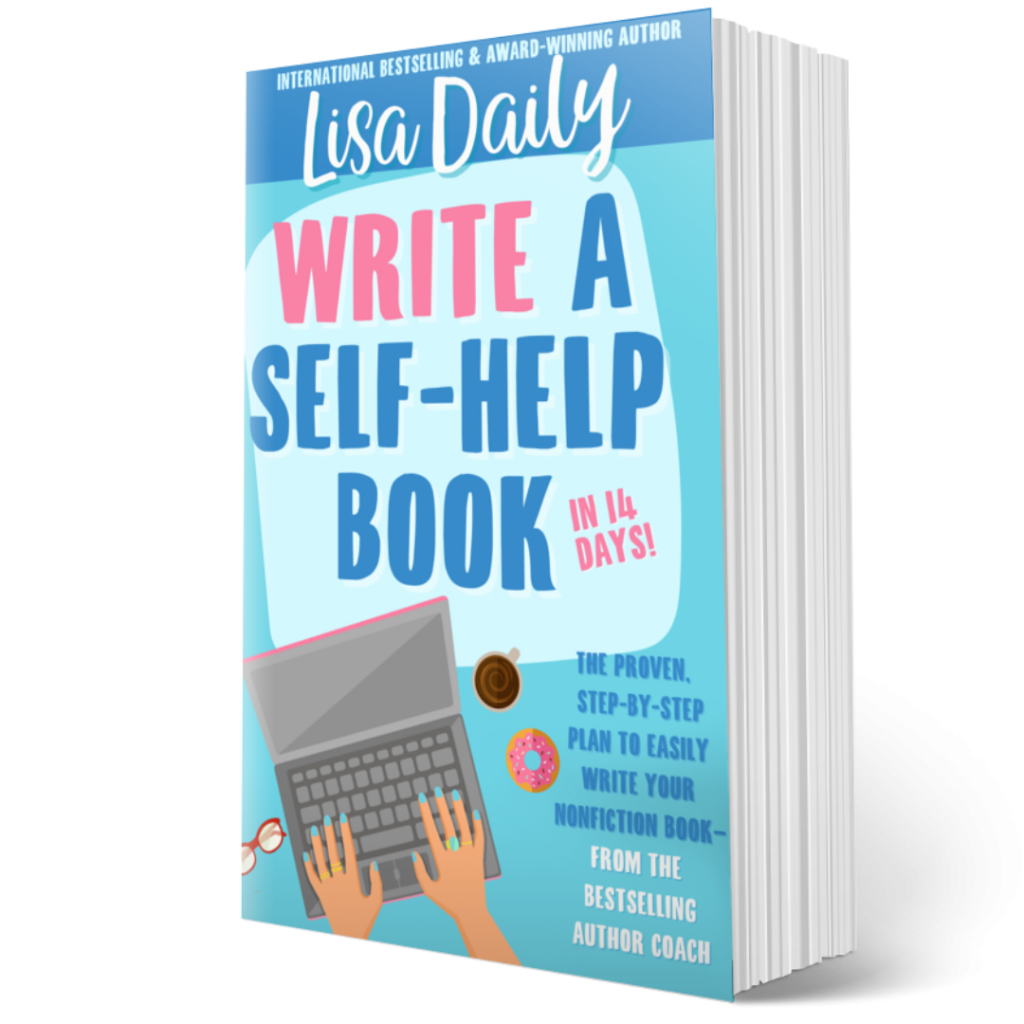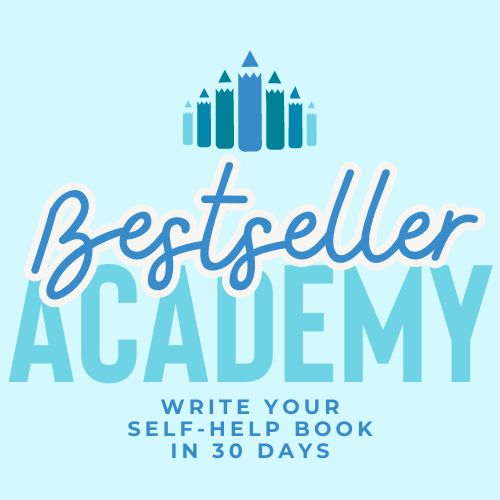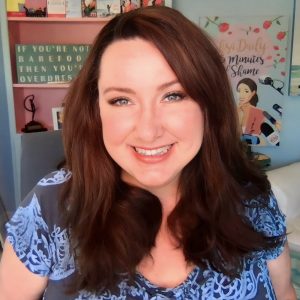

Today we’re talking about how to write a personal development book!
Writing a personal development book is a transformative journey that allows authors to share their insights, experiences, and expertise with readers seeking growth and self-improvement.
Whether you’re a seasoned expert in your field or someone with a unique perspective to offer, writing a personal development book requires careful planning, dedication, and a commitment to making a positive impact. In this comprehensive guide, we’ll explore the essential steps and strategies for writing a compelling personal development book that resonates with your audience, builds your business, and fosters meaningful change.
How to Write a Personal Development Book
It’s easier than you think when you have a plan of action.
1. Define your purpose and audience
How do you write self-help? Before you ever start writing a word, take the time to clarify your purpose for writing the book and identify your target audience. What specific problem or challenge does your book address? Who are the people who will benefit most from reading it? Will you write a standard self-help book or a self-help memoir? Understanding your purpose and audience will help you tailor your content to meet their needs and interests effectively.
I always start any personal development book project with my Creative Work Plan (CWP) which helps me nail down all those important questions right off the bat, making it far easier once it’s time to actually start writing the book. Download my Creative Work Plan here.
2. Choose your topic and angle
Personal development is a broad and diverse field, encompassing topics such as self-esteem, goal setting, relationships, mindfulness, productivity, and more. When contemplating self-help book ideas, consider your own experiences, expertise, and passions when choosing a topic for your book. What unique insights or perspectives can you offer? How can you approach the topic in a way that stands out from existing books in the market?
3. Consider how your book will help you build or scale your business
When writing a personal development book, it’s essential to consider how the publication can serve as a powerful tool for building or scaling your business. Beyond simply sharing insights and experiences, your book can establish you as an authority in your field, increasing your visibility and credibility among potential clients, customers, and partners.
By strategically incorporating your business objectives and offerings into the content of the book, you can seamlessly integrate your message with your business goals, attracting new leads, opportunities, and revenue streams. Additionally, leveraging your book as a cornerstone of your marketing strategy, you can create ancillary products and services, such as workshops, courses, coaching programs, and speaking engagements, to further expand your business reach and impact. Ultimately, your book serves as a catalyst for growth and success, propelling your business to new heights while empowering readers to achieve their own personal and professional aspirations.
4. Conduct research and gather resources
Once you’ve chosen your topic, conduct thorough research to deepen your understanding and gather relevant resources. This may include reading books and articles, attending workshops or seminars, interviewing experts, and drawing from your own experiences and observations, or the experiences of your clients or peers. Take notes, organize your research materials, and keep track of sources to ensure accuracy and credibility in your writing.

5. Develop your outline
How do you outline a personal development book? Create a detailed outline that outlines the structure and flow of your book. Break down your content into chapters or sections, and outline the key points, subtopics, and examples you plan to cover in each. A well-organized outline serves as a blueprint for your writing process, helping you stay focused and on track as you draft your manuscript.
What is the format of a self-help book? How you structure your book is as important as the topic of your book – if you miss those critical opportunities to bond with your reader and address their pain points, you dramatically decrease the effectiveness and sharability of your book.
Get my free self-help book template download.
6. Write with clarity and authenticity
As you write, strive for clarity, authenticity, and engaging storytelling. Use simple language and avoid jargon or technical terms that may alienate readers. Share personal anecdotes, case studies, and real-life examples to illustrate your points and make them relatable to your audience. Be genuine and vulnerable in your writing, allowing readers to connect with you on a deeper level.
7. Provide an Action Plan for your reader
One of the hallmarks of a successful personal development book is its ability to offer practical advice and actionable strategies that readers can apply to their own lives. The best self-help books provide step-by-step guidance, exercises, and tools that empower readers to take concrete action toward their goals and aspirations. Encourage experimentation, reflection, and ongoing growth throughout the book.
8. Edit and revise
Editing is a critical part of the writing process that ensures clarity, coherence, and polish in your manuscript. Review your draft carefully, paying attention to grammar, punctuation, spelling, and sentence structure. Consider hiring a professional editor or asking trusted peers to provide feedback on your work. Revise your manuscript based on their suggestions, refining your ideas and tightening your prose for maximum impact.
9. Design your book
Consider the visual elements of your book, including cover design, layout, typography, and graphics. A visually appealing and professionally designed book enhances its perceived value and attractiveness to readers. Work with a skilled graphic designer or use self-publishing platforms that offer design templates and tools to create a polished and professional-looking book.
10. Choose your publishing path
Decide whether you want to pursue traditional publishing or self-publishing for your book. Traditional publishing involves submitting your manuscript to literary agents or publishers and following their editorial and production processes. Self-publishing allows you to retain full control over the publishing process and distribution of your book, but requires you to handle tasks such as editing, formatting, and marketing on your own or with the help of professional services.
11. Market and promote your book
Regardless of your publishing path, effective marketing and promotion are essential for reaching your target audience and generating interest in your book. Develop a marketing plan that includes strategies such as social media promotion, email marketing, book signings, speaking engagements, and collaborations with influencers or fellow authors. Leverage your online presence and networks to build buzz and anticipation for your book launch.
12. Engage with your readers
Once your book is published, engage with your readers through various channels, including social media, author website, email newsletter, and book events. Encourage feedback, reviews, and testimonials from readers, and use their insights to inform future writing projects and marketing efforts. Building a loyal and engaged readership is key to sustaining your author career and making a lasting impact with your writing.
Writing a personal development book is a challenging yet immensely rewarding endeavor that offers authors like you the opportunity to share their wisdom, insights, and experiences with a wider audience. By following these steps and strategies, you can create a compelling and impactful book that resonates with readers, fosters positive change, and leaves a lasting legacy.
How long should a personal development book be?
The ideal length of a personal development book can vary depending on factors such as the complexity of the topic, the depth of the content, and the preferences of the target audience. While there is no one-size-fits-all answer, personal development books typically range from around 20,000 to 80,000 words in length. That’s a big range!
Rather than aiming for a specific word count, a good rule of thumb is to write as much or as little as you need to provide your reader with an actionable plan to grow or change their life. For years, my best-selling personal development book was a dating advice book that clocked in around 20,000 words.
The 20K – 80K sweet spot allows authors to delve into their subject matter in sufficient detail, providing readers with comprehensive insights, actionable strategies, and practical advice. However, some personal development books may be shorter, focusing on a specific aspect of personal growth or offering concise, to-the-point guidance.
Personal development books that are part memoir, part self-help tend to run a bit longer, upwards of 120k words.
Ultimately, the length of your personal development book should be determined by the depth and breadth of the content, ensuring that it effectively addresses the needs and interests of your readers while maintaining their engagement from start to finish.
Don’t pad it, and don’t skimp – your book should be exactly as long as it needs to be.
Can anyone write a self-help book?
Can anybody write a self-help book? While anyone can technically write a self-help book, crafting a truly impactful and valuable resource requires a unique combination of expertise, empathy, and dedication.
Writing a self-help book involves more than simply sharing personal anecdotes or dispensing advice; it requires a deep understanding of the subject matter, as well as the ability to communicate complex ideas in a clear and accessible manner.
Additionally, successful self-help authors possess a genuine desire to help others, along with the humility to acknowledge their own limitations and ongoing journey of personal growth. While not everyone may have the necessary skills or experience to write a self-help book, those who are passionate, knowledgeable, and committed to making a positive difference in the lives of others can certainly aspire to do so with sincerity and authenticity.

I Want to Write a Book, Where Do I Start?
👉 If you want to write your own personal development book, start with this one: Write a Self-Help Book in 14 Days: The proven, step-by-step plan to easily write your nonfiction book – from the bestselling author coach.
🎉 Get my free self-help book template download.
💥 Or sign up for the Bestseller Academy’s Write a Self-Help Book in 30 Days course.
What should be included in a self-help book?
Your successful self-help book should include a combination of key elements that engage, educate, and empower readers on their journey of personal growth and development.
First and foremost, the book should clearly define its purpose and target audience, addressing a specific problem or challenge that readers are facing.
Practical advice, actionable strategies, and evidence-based insights should be presented in a clear, concise manner, supported by real-life examples, case studies, and exercises that encourage reflection and application.
Additionally, the book should foster a sense of connection and empathy with readers, acknowledging their struggles and offering encouragement and support along the way.
A well-structured format, engaging writing style, and compelling storytelling can further enhance the readability and impact of the book, inspiring readers to take positive action and make meaningful changes in their lives.
How many pages is the average self-help book?
The number of pages in a personal development book can vary widely depending on factors such as the depth of the content, the complexity of the topic, and the author’s writing style. Generally, personal development books range from around 150 to 300 pages in length, although some may be shorter or longer depending on the specific focus and intended audience.
You’ll want to strive to strike a balance between providing comprehensive insights and practical guidance while maintaining your reader’s engagement and interest throughout the book. Ultimately, the length of a personal development book should be determined by the depth and breadth of the content – it should effectively addresses the needs and interests of your readers while delivering a transformative reading experience.

Is there a course for writing a selfhelp book?
Is there a course for writing a selfhelp book? Yes, there are several courses available for individuals interested in writing a self-help book. If you’ve been wondering, How do I write a self-help book with no experience, these classes are designed to guide aspiring authors through every stage of the writing process, from refining their book idea to publishing and marketing their finished manuscript.
Depending on the course provider, participants may learn essential skills such as developing a compelling book concept, structuring their content effectively, crafting engaging prose, and navigating the publishing industry. Courses like the Bestseller Academy’s Write a Self-Help Book in 30 Days class are led by a bestselling author, offering personalized feedback, coaching, and support to help students hone their writing skills and quickly bring their vision to life.
Whether through online platforms, writing workshops, or university programs, aspiring self-help authors can find a variety of resources and opportunities to learn and grow as they embark on their writing journey.


3 Responses